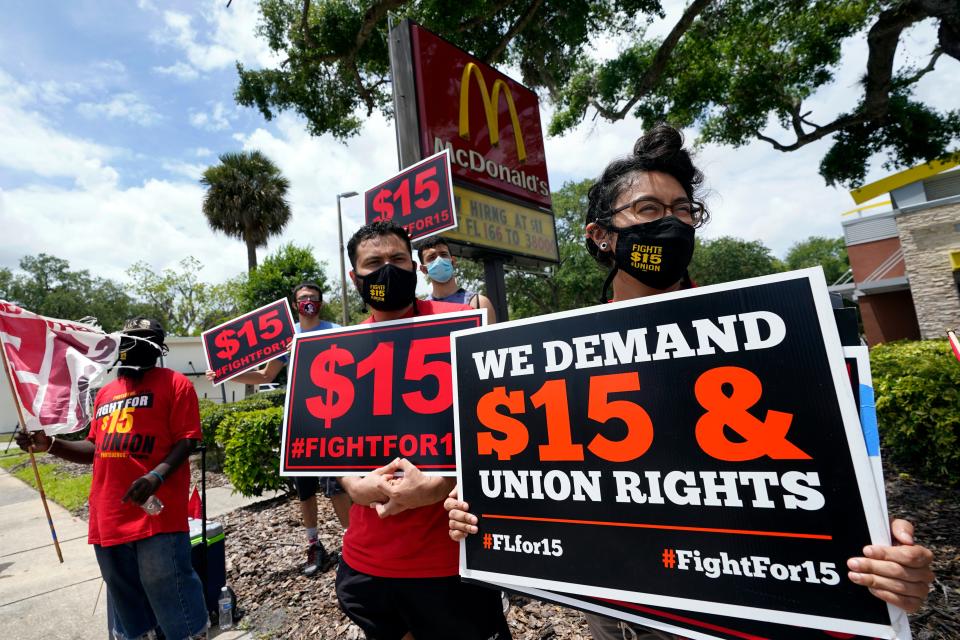Rising retail, restaurant, fast-food wages make hiring tougher for manufacturing, construction, health care
Faye Ashley seemed destined for a career as a dental assistant.
Her mother was a nurse, her sister, a nurse practitioner.
She took yearlong dentistry courses at a Pennsylvania community college before landing a $10.50-an-hour job at a small practice in Greensburg, Pennsylvania.
Ashley enjoyed calming patients’ nerves and saw her hourly wages climb to $21 over a dozen years, most recently at a dental office in Woodstock, Virginia.
But when day care centers shut down as the COVID-19 pandemic began in spring 2020, the single mother quit to care for her two young daughters and never returned.
“Everything has changed since COVID,” Ashley, 40, says. “You have to gown up, wear a head wrap, double mask, there’s so much to do…And you’re working with aerosols (tiny droplets in the air from patients’ mouths) all day. It just gave me so much anxiety about going back to that field.”
Ashley now works part time as a bartender at a Woodstock area brew pub, taking home about $1,400 every two weeks – 40% more than her dental job – while putting in half the hours.
“It’s very much less stressful,” she says. “I can go to work in a T-shirt, jeans and tennis shoes.…And I have all day to be with my kids – go to the pool, hike.”
Restaurant, fast-food and retail pay has risen sharply, especially since the pandemic triggered widespread labor shortages, presenting fresh competition to higher-skill fields like health care, manufacturing and construction in the battle for workers.
For entry-level positions – such as certified nursing assistant, welder and painter – wages have broadly converged in the $15 to $18 an hour range, with fast-food and retail pay often near or above the skilled roles, experts say.
Before the health crisis, base wages for retail and food services were $10 to $12 an hour while skilled fields typically paid 15% to 20% more, says Greg Sulentic, owner of an Express Employment Professionals staffing franchise in Lincoln, Nebraska.
“All of the (entry-level) labor is paid very similarly with small gaps between them,” says David Turetsky, vice president of consulting for Salary.com, which researches employee compensation trends. “We call that a flattening of the wage structure.”
That’s unusual, he adds. “You’re comparing somebody who has to go get a license” or other training to a job “that requires only a high school education.”
At the same time, retail and food service jobs generally offer more flexible hours; controlled, indoor conditions; and fast-paced, social environments that appeal to young adults.
The competition is compounding the skilled industries’ struggles to attract and retain workers, forcing companies to boost pay still higher or break out of decades-old molds. Some manufacturers and health care providers are setting up shorter shifts to accommodate parents while some construction companies are offering health benefits.
The additional costs are intensifying inflation that’s been stuck at a 40-year high, Turetsky says. The June jobs report, due out Friday, is expected to reveal that wages grew solidly again last month, though the pace has moderated.
Need a raise?: You can still nab that raise despite inflation. How companies can still afford benefits.
Retailers and restaurants, meanwhile, are tapping a larger pool of job candidates, including more educated workers looking to carve out middle-class careers rather than simply experience a teenage rite of passage.
Minimum wage hikes help fuel trend
Fast-food and retail wages were already rising as a result of highly publicized worker strikes and legislation or ballot initiatives that raised minimum wages across the country.
California and much of New Yorkstate are already at or above $15 an hour, as are some 30 cities, including Seattle.
The pandemic drove earnings still higher by worsening labor shortages as millions of employees left the workforce because of COVID-19 fears or to care for young children. As Americans returned to dining out and shopping in large numbers, fast-food and big-box stores had little choice but to sharply lift their pay floors to handle the sales surge.
Dozens of household names pay a starting wage of $15, including Target, Starbucks, CVS, Best Buy and Sam’s Club, as well as health and other benefits for full-time employees. Target and others also offer generous tuition reimbursement programs in the hope that employees will stay and move up the management ranks.
Despite early signs of a slowing economy, there were 10.7 million job openings in June, or nearly two for every unemployed person.
To recruit skilled workers, “You’ve got to steal them from other companies” and industries, Sulentic, the Nebraska staffing official, says.
Health care providers lost hundreds of thousands of employees to burnout during the pandemic. Although the companies are lifting pay to attract workers, money is just part of the draw.
“You have to find a person who is passionate about it,” says Ashraf Shehata, national service leader for health care and life sciences at KPMG.
'Why are you slinging beer?'
Ashley, the dental assistant, wasn’t short on passion.
She enjoyed letting patients know that “everything is going to be OK and if you feel pain just let us know and we’ll go slower.” She also took pride in anticipating the next instrument the dentist needed “without his having to ask. I was very good at what I did.”
No-bid COVID contracts and politics: Republican governors gave lucrative, no-bid COVID-19 deals to Utah firms, who then gave $1M to GOP campaigns
Now, when she tells people what she does for a living, she acknowledges it rankles that some “really look down on you, like ‘Why are you slinging beer?’

Would she go back to dentistry?
“It’s hard to take a pay cut to go back into health care,” she says. Although she earns a $5 hourly wage, tips have increased as menu prices have risen. (Restaurants in many states can pay below the federal or state minimum wages if an employee earns an offsetting amount in tips)
She also enjoys the more flexible hours the restaurant allows. “I want to see my kids,” 5- and 7-year-old girls, she says. “Maybe when they’re older.”

Responding to such post-COVID-19 priorities, some health care providers are starting to split eight-hour shifts into two four-hour stints, Shehata says.
Health care, manufacturing and construction jobs still boast higher average pay, underscoring that employees can more easily enhance their skills and rise to more lucrative positions.
But the gap is shrinking.
In June, average pay in manufacturing was $30.86 an hour, 35% higher than retail, but down from 40% three years earlier, U.S. Labor Department figures show. Construction was 51.6% higher than retail, down from 56% in 2019.
And while manufacturers can entice candidates with appealing career ladders, “They have to get people through the door” with entry-level jobs, says Heather Ashton Manolian, manufacturing research lead for consulting firm Deloitte. That can be challenging, she says, pointing to an outmoded perception of the industry from its “dirty, dark days,” prior to sweeping technological changes.
The parents shift
Yasufuku USA, which makes parts for cars, jet skis and farming vehicles, received two or three applications for a job opening before the pandemic, says Senior Manager Carsen Kuehl. Now, “We’re probably lucky to get one,” he says.
Yasufuku, with a 65-employee plant in Lincoln, Nebraska, has hiked its starting hourly pay from $12 to $14.50. Still, job applicants, who must take 90 days of on-the-job training if they’re hired, sometimes tell him, “ ‘I can go work for McDonald’s for $15 an hour,’ ” Kuehl says. That, he says, has led the company to boost its base pay to about $15.50 this month.
And while many fast-food and retail workers log part-time hours, manufacturers generally are locked into three, eight-hour shifts over 24 hours. Machines can’t be stopped once they’re revved up and each step in production hinges on others.
To attract and retain workers, Kuehl recently launched an 8:30 a.m. to 3 p.m. shift so parents can drop off their kids at school in the morning and pick them up mid-afternoon. Employees on the “parents shift” test fuel tanks for leaks, inspect parts and assemble air cleaners by hand – tasks that don’t require starting or stopping injection-molding machines.
“It is helping” to some extent, Kuehl says, noting that none of the handful of workers in the program has left the company.
“Are you looking for a job or are you looking for a career?” Kuehl asks, alluding to the competition from the service industries. "(At Yasufuku), they can learn a skill that will be very valuable.”
“Companies are trying to see what they can do to accommodate parents but it is not always possible,” says Chad Moutray, chief economist of the National Association of Manufacturers.
'We need to change the model'
Construction companies face other dilemmas. Many crews are made up of nomadic workers who generally don’t get benefits and aren’t paid at all if work is suspended by rain.
Amid the intense competition from other industries, “We need to change the model,” says Ed Brady, CEO of the Home Builders Institute, which trains workers. “It is not sustainable. We need to offer stability.”
Turning Leaf Construction, an energy-efficient custom home builder in Sanford, Florida, is trying.
It has raised its starting hourly wage for laborers from about $12 to $15 over the past few years but new candidates still gripe that they can work in a climate-controlled, fast-food setting instead of the Florida heat “and make the same amount of money,” says company CEO John Riddle.
Turning Leaf is seeking to add four workers to an eight-person crew that makes wall panels insulated with foam and reinforced with concrete but applications are scarce, Riddle says. New hires must take a 12-week training program. “It doesn’t do any good to bring them in and six weeks later they’re gone,” he says, noting one or two recently bolted for retail jobs.
Riddle recently decided to offer health coverage to all employees, an anomaly in the construction industry.
“You have to,” he says, adding that retailers and fast-food restaurants are providing such benefits.
Mild recession?: A recession is at the doorstep. Here's why it may not be as bad as you might think
Retailers take advantage of shift
Those industries are also making the most of the more level playing field.
Last year, ECI Stores, a chain of clothing and furniture consignment shops in Leominster, Massachusetts, hired a hospital pharmacy technician as a retail associate, says co-owner Neil Abramson.
He says she’s earning $2 an hour less than she did in health care but her new job is far less stressful.
Before he raised his base wage from $12 to $15, “I would never have thought about taking someone from…health care,” Abramson says. The employee, he says, is demonstrating more leadership than typical associates, redesigning a display window.
Retailers also are increasingly touting long-term career opportunities.
“A lot of people see retail as a stepping stone,” says Mark Matthews, a vice president at the National Retail Federation. “There is a real career path.”
This summer, Walmart rolled out a College2Career program that allows recent college graduates to rotate among different departments and become store managers with a $210,000 salary within two years.
Aleia Marino, 20, of East Liverpool, Ohio, who started working as a Walmart checkout host at 17, decided to forgo her dream of becoming a kindergarten teacher to join the program.

“When I became 18, I knew I wanted to make Walmart my career,” she says.
Paul Davidson is USA TODAY's senior economics correspondent. You can follow him on Twitter @PDavidsonusat and subscribe to our free Daily Money newsletter for personal finance tips and business news every Monday through Friday morning.
This article originally appeared on USA TODAY: U.S. wage growth: Retail, restaurant pay now rivals skilled jobs


